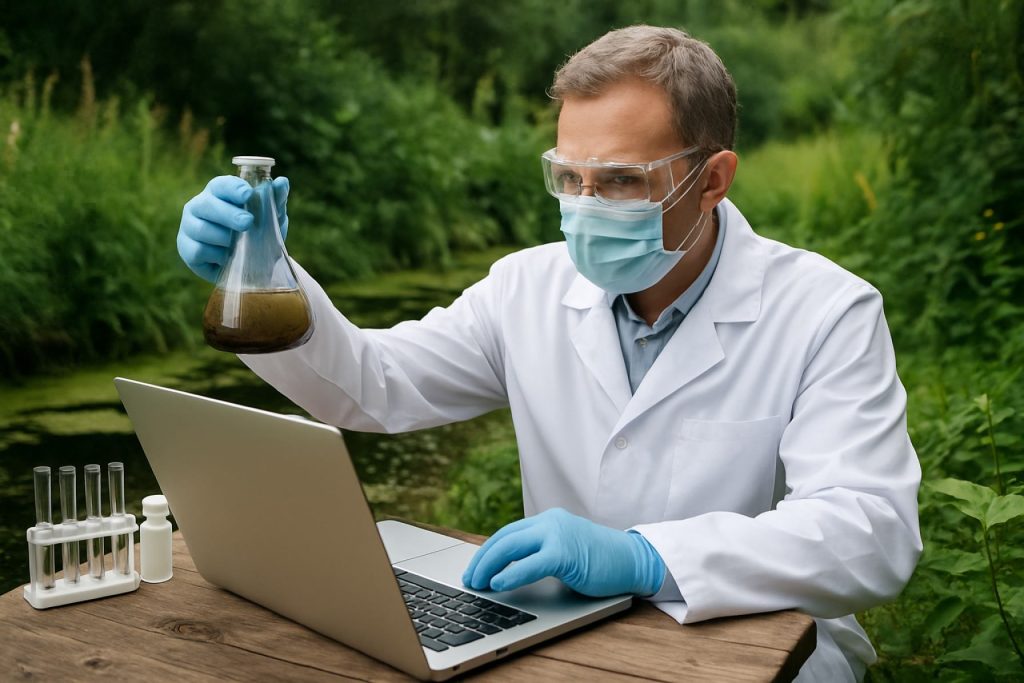
Microbial Bioremediation Solutions Market Report 2025: In-Depth Analysis of Growth Drivers, Technology Innovations, and Global Opportunities. Explore Key Trends, Forecasts, and Strategic Insights for Industry Stakeholders.
- Executive Summary & Market Overview
- Key Market Drivers and Restraints
- Technology Trends in Microbial Bioremediation
- Competitive Landscape and Leading Players
- Market Size, Share, and Growth Forecasts (2025–2030)
- Regional Analysis: North America, Europe, Asia-Pacific, and Rest of World
- Emerging Applications and End-User Insights
- Challenges, Risks, and Regulatory Considerations
- Opportunities and Future Outlook
- Sources & References
Executive Summary & Market Overview
Microbial bioremediation solutions refer to the use of microorganisms—such as bacteria, fungi, and algae—to degrade, detoxify, or remove environmental contaminants from soil, water, and air. This approach leverages the natural metabolic processes of microbes to break down hazardous substances, offering a sustainable and cost-effective alternative to traditional remediation methods. In 2025, the global market for microbial bioremediation solutions is experiencing robust growth, driven by increasing environmental regulations, heightened public awareness of pollution, and the urgent need for effective remediation of industrial waste and oil spills.
According to recent market analyses, the microbial bioremediation market is projected to reach a value of USD 4.2 billion by 2025, growing at a compound annual growth rate (CAGR) of approximately 8.5% from 2020 to 2025. This growth is underpinned by the expanding adoption of bioremediation technologies in sectors such as oil & gas, agriculture, mining, and municipal waste management. Notably, North America and Europe remain the leading regions due to stringent environmental policies and significant investments in research and development, while Asia-Pacific is emerging as a high-growth market owing to rapid industrialization and increasing environmental concerns (MarketsandMarkets).
Key drivers shaping the market in 2025 include the rising incidence of oil spills and chemical leaks, the growing prevalence of contaminated sites, and the shift towards eco-friendly remediation practices. Governments and regulatory bodies are increasingly mandating the use of sustainable remediation solutions, further accelerating market adoption. Additionally, advancements in microbial engineering and genomics are enabling the development of highly specialized microbial consortia tailored to specific contaminants, enhancing the efficacy and scope of bioremediation applications (Grand View Research).
- Oil & gas sector: Major driver due to frequent hydrocarbon contamination incidents.
- Agriculture: Growing use of microbial solutions to remediate pesticide and fertilizer residues.
- Municipal waste: Increasing deployment in landfill leachate and sewage treatment.
Despite the positive outlook, challenges such as variable site conditions, regulatory complexities, and the need for site-specific microbial formulations persist. However, ongoing innovation and supportive policy frameworks are expected to mitigate these barriers, positioning microbial bioremediation as a cornerstone of the global environmental remediation industry in 2025 (Allied Market Research).
Key Market Drivers and Restraints
Microbial bioremediation solutions are gaining traction as sustainable and cost-effective approaches for addressing environmental contamination in soil, water, and industrial effluents. The market for these solutions in 2025 is shaped by a dynamic interplay of drivers and restraints that influence adoption rates and technological advancements.
Key Market Drivers
- Stringent Environmental Regulations: Governments worldwide are enforcing stricter regulations on industrial waste management and pollution control, compelling industries to adopt eco-friendly remediation technologies. For instance, the U.S. Environmental Protection Agency and the European Commission have set rigorous standards for soil and groundwater decontamination, directly boosting demand for microbial bioremediation.
- Rising Incidence of Industrial Pollution: The expansion of manufacturing, mining, and petrochemical sectors has led to increased contamination of natural resources. This trend is particularly pronounced in emerging economies, where rapid industrialization often outpaces environmental safeguards, creating a robust market for remediation solutions.
- Advancements in Microbial Engineering: Innovations in synthetic biology and genomics are enabling the development of highly efficient microbial strains tailored for specific contaminants. Companies such as BASF and Novozymes are investing in R&D to enhance the efficacy and scalability of microbial products, making them more attractive to end-users.
- Growing Public Awareness and Corporate Sustainability Initiatives: Heightened awareness of environmental issues and the adoption of ESG (Environmental, Social, and Governance) frameworks by corporations are driving investments in green technologies, including bioremediation.
Key Market Restraints
- Technical Limitations and Site-Specific Challenges: The effectiveness of microbial bioremediation can be hindered by factors such as soil composition, contaminant type, and environmental conditions. These site-specific variables often necessitate customized solutions, increasing complexity and cost.
- Slow Remediation Rates: Compared to some chemical or physical remediation methods, microbial processes can be slower, which may deter adoption in projects requiring rapid turnaround.
- Regulatory and Approval Hurdles: The introduction of genetically modified or non-native microbial strains is subject to rigorous regulatory scrutiny, particularly in regions with strict biosafety laws, potentially delaying market entry.
- Limited Awareness in Developing Regions: Despite growing global interest, knowledge gaps and limited technical expertise in certain markets, especially in parts of Africa and Asia, can restrict uptake.
Technology Trends in Microbial Bioremediation
Microbial bioremediation solutions are rapidly evolving, driven by advances in biotechnology, genomics, and process engineering. In 2025, the sector is witnessing a shift from traditional, naturally occurring microbial consortia to highly tailored, engineered microbial strains designed for specific contaminant degradation. This trend is underpinned by breakthroughs in synthetic biology, enabling the creation of microbes with enhanced metabolic pathways for the breakdown of persistent organic pollutants, heavy metals, and hydrocarbons.
One of the most significant technology trends is the deployment of genetically modified microorganisms (GMMs) that exhibit superior efficiency and resilience in harsh environmental conditions. These GMMs are being developed to target contaminants such as polychlorinated biphenyls (PCBs), polycyclic aromatic hydrocarbons (PAHs), and chlorinated solvents, which are traditionally challenging to remediate. Companies like BASF and Dow are investing in research collaborations to commercialize such advanced microbial solutions, aiming to reduce remediation timelines and costs.
- Bioaugmentation and Biostimulation: The integration of bioaugmentation (introduction of specialized microbial strains) and biostimulation (optimization of environmental conditions to enhance native microbial activity) is becoming standard practice. This dual approach is being refined through real-time monitoring and adaptive process control, leveraging IoT sensors and AI-driven analytics to optimize remediation outcomes.
- Consortia Engineering: There is a growing emphasis on engineering microbial consortia—communities of synergistic microbes—that can collectively degrade complex contaminant mixtures. This approach is particularly effective in treating industrial effluents and mixed waste streams, as demonstrated in pilot projects supported by U.S. Environmental Protection Agency (EPA) grants.
- In Situ and Ex Situ Applications: Technological advancements are enabling more efficient in situ (on-site) bioremediation, reducing the need for costly excavation and transport. Mobile bioreactor systems and modular treatment units are also gaining traction for ex situ applications, offering flexibility and scalability for diverse site conditions.
Market data from MarketsandMarkets projects the global bioremediation market to reach USD 20.3 billion by 2025, with microbial solutions accounting for a significant share due to their cost-effectiveness and environmental compatibility. As regulatory pressures mount and sustainability goals intensify, the adoption of next-generation microbial bioremediation technologies is expected to accelerate across sectors such as oil & gas, agriculture, and municipal waste management.
Competitive Landscape and Leading Players
The competitive landscape for microbial bioremediation solutions in 2025 is characterized by a mix of established environmental service providers, biotechnology firms, and emerging startups, all vying for market share in a sector driven by increasing regulatory pressures and heightened environmental awareness. The market is moderately fragmented, with leading players differentiating themselves through proprietary microbial consortia, advanced delivery systems, and integrated service offerings.
Key players in this space include Xylem Inc., which leverages its global presence and expertise in water technologies to offer bioremediation solutions for wastewater and contaminated groundwater. Veolia Environnement S.A. remains a dominant force, providing comprehensive site remediation services that incorporate microbial technologies for soil and water decontamination. REGENESIS specializes in in-situ remediation products, such as bioaugmentation agents and electron donors, targeting petroleum hydrocarbons and chlorinated solvents.
Biotechnology-focused companies like Novozymes A/S are notable for their development of tailored microbial strains and enzyme-based solutions, addressing specific contaminants and site conditions. Microbial Insights, Inc. stands out for its molecular biological tools that support site assessment and monitoring, enabling more precise and effective bioremediation strategies.
Startups and regional players are also making significant inroads, particularly in emerging markets where local expertise and cost-effective solutions are in demand. Companies such as Ochre Bio and Terrapure Environmental are leveraging innovations in synthetic biology and process optimization to address niche applications and complex contamination scenarios.
Strategic partnerships, mergers, and acquisitions are common as firms seek to expand their technological capabilities and geographic reach. For example, recent collaborations between technology developers and environmental engineering firms have accelerated the commercialization of next-generation microbial consortia and real-time monitoring platforms. The competitive intensity is further heightened by the entry of academic spin-offs and research-driven enterprises, which are translating laboratory breakthroughs into scalable, field-ready solutions.
Overall, the 2025 market for microbial bioremediation solutions is defined by innovation, service integration, and a growing emphasis on sustainability, with leading players investing heavily in R&D to maintain their competitive edge and address evolving regulatory and client demands.
Market Size, Share, and Growth Forecasts (2025–2030)
The global market for microbial bioremediation solutions is poised for significant expansion in 2025, driven by increasing environmental regulations, heightened awareness of sustainable remediation practices, and technological advancements in microbial engineering. According to projections by MarketsandMarkets, the bioremediation technology and services market is expected to reach approximately USD 18.7 billion in 2025, with microbial solutions constituting a substantial share due to their efficacy in treating oil spills, heavy metals, and organic pollutants.
In 2025, North America is anticipated to maintain its dominance, accounting for over 35% of the global market share, propelled by stringent environmental policies from agencies such as the U.S. Environmental Protection Agency and ongoing remediation projects in the United States and Canada. Europe follows closely, with the European Union’s Green Deal and circular economy initiatives fostering demand for eco-friendly remediation technologies. The Asia-Pacific region is projected to exhibit the fastest growth rate, with countries like China and India investing heavily in pollution control and brownfield redevelopment, as noted by Fortune Business Insights.
From 2025 to 2030, the microbial bioremediation solutions market is forecasted to grow at a compound annual growth rate (CAGR) of 8–10%, outpacing traditional remediation methods due to lower operational costs, minimal environmental disruption, and the ability to target a wide range of contaminants. Key market segments include soil remediation, wastewater treatment, and oil spill management, with soil remediation expected to remain the largest segment through 2030. The adoption of genetically engineered microbes and consortia-based approaches is anticipated to further accelerate market growth, as highlighted by Grand View Research.
- Market Size (2025): USD 18.7 billion (bioremediation technology and services)
- Key Regions: North America (35%+ share), Europe, Asia-Pacific (fastest growth)
- CAGR (2025–2030): 8–10%
- Leading Segments: Soil remediation, wastewater treatment, oil spill management
Overall, the period from 2025 to 2030 is expected to witness robust growth in microbial bioremediation solutions, underpinned by regulatory support, technological innovation, and the global shift toward sustainable environmental management.
Regional Analysis: North America, Europe, Asia-Pacific, and Rest of World
The global market for microbial bioremediation solutions is experiencing differentiated growth across key regions—North America, Europe, Asia-Pacific, and the Rest of the World—driven by varying regulatory frameworks, industrialization rates, and environmental priorities.
North America remains a leading market, propelled by stringent environmental regulations and significant investments in sustainable remediation technologies. The United States Environmental Protection Agency (EPA) continues to support bioremediation projects for soil and groundwater contamination, particularly at Superfund sites. The presence of established players and advanced R&D infrastructure further accelerates adoption. Canada is also witnessing increased uptake, especially in the oil sands and mining sectors, where microbial solutions are deployed to address hydrocarbon and heavy metal pollution (United States Environmental Protection Agency).
Europe is characterized by robust regulatory support under the European Green Deal and the Soil Strategy for 2030, which prioritize the restoration of contaminated sites using eco-friendly methods. Countries such as Germany, the Netherlands, and the UK are at the forefront, leveraging public-private partnerships and funding for bioremediation research. The region’s focus on circular economy principles and sustainable land management is expected to drive further market expansion (European Commission).
Asia-Pacific is emerging as the fastest-growing region, fueled by rapid industrialization, urbanization, and increasing awareness of environmental health. China and India, in particular, are investing in microbial bioremediation to address widespread soil and water contamination from manufacturing, agriculture, and municipal waste. Government initiatives, such as China’s “Soil Pollution Prevention and Control Action Plan,” are catalyzing market growth, while Japan and South Korea are integrating bioremediation into broader environmental restoration programs (Ministry of Ecology and Environment of the People’s Republic of China).
- Rest of the World (including Latin America, Middle East, and Africa) is gradually adopting microbial bioremediation, primarily in response to oil spills, mining activities, and agricultural runoff. Brazil and South Africa are notable for pilot projects and collaborations with international agencies, though market penetration remains limited by funding and technical expertise (United Nations Environment Programme).
Overall, regional dynamics in 2025 reflect a convergence of regulatory pressure, environmental necessity, and technological innovation, with Asia-Pacific poised for the highest growth rate, while North America and Europe maintain leadership in market maturity and innovation.
Emerging Applications and End-User Insights
Microbial bioremediation solutions are rapidly gaining traction across diverse industries as organizations seek sustainable and cost-effective methods for environmental cleanup. In 2025, emerging applications are expanding beyond traditional soil and groundwater remediation to include complex scenarios such as oil spill management, industrial wastewater treatment, and even the restoration of mining sites. The adoption of advanced microbial consortia—engineered or naturally occurring communities of bacteria, fungi, and archaea—enables the targeted breakdown of persistent organic pollutants, heavy metals, and hydrocarbons, offering tailored solutions for site-specific challenges.
One of the most significant trends is the integration of microbial bioremediation in the oil and gas sector. Companies are leveraging specialized microbial strains to degrade petroleum hydrocarbons in contaminated soils and marine environments, reducing reliance on chemical dispersants and physical removal methods. For instance, pilot projects in North America and the Middle East have demonstrated up to 80% reduction in total petroleum hydrocarbons within six months, highlighting the efficacy and scalability of these biological approaches (International Energy Agency).
Industrial wastewater treatment is another area witnessing robust growth. Food processing, textile, and pharmaceutical manufacturers are increasingly deploying microbial solutions to remove dyes, phenols, and other toxic compounds from effluents before discharge. This not only ensures regulatory compliance but also supports corporate sustainability goals. According to recent market analyses, the global demand for microbial-based wastewater treatment is projected to grow at a CAGR of over 9% through 2025 (MarketsandMarkets).
End-user insights reveal a shift in perception among municipal authorities and private enterprises. There is a growing preference for bioremediation due to its lower environmental footprint, reduced secondary pollution, and potential for in-situ application, which minimizes site disruption. Additionally, advancements in metagenomics and bioinformatics are enabling more precise monitoring and optimization of microbial activity, further boosting end-user confidence (Frost & Sullivan).
- Oil & gas: Rapid adoption for spill remediation and site restoration.
- Industrial manufacturing: Integration into wastewater treatment and hazardous waste management.
- Mining: Use in heavy metal detoxification and tailings management.
- Municipalities: Application in landfill leachate treatment and brownfield redevelopment.
As regulatory pressures mount and environmental awareness grows, the landscape for microbial bioremediation solutions in 2025 is characterized by innovation, cross-sector collaboration, and a clear shift toward biological over chemical remediation strategies.
Challenges, Risks, and Regulatory Considerations
Microbial bioremediation solutions, while promising for addressing environmental contamination, face a complex landscape of challenges, risks, and regulatory considerations as the market advances into 2025. One of the primary challenges is the variability in site-specific conditions—such as temperature, pH, contaminant concentration, and indigenous microbial communities—which can significantly impact the efficacy of introduced or stimulated microbes. This unpredictability often necessitates extensive site assessment and pilot studies, increasing project costs and timelines (U.S. Environmental Protection Agency).
Another significant risk is the potential for unintended ecological consequences. The introduction of non-native or genetically modified microorganisms, while sometimes necessary for degrading specific pollutants, raises concerns about horizontal gene transfer, disruption of local ecosystems, and the creation of new pathogenic strains. These biosafety risks require rigorous containment strategies and post-application monitoring (World Health Organization).
From a regulatory perspective, microbial bioremediation is subject to a patchwork of national and regional frameworks. In the United States, the U.S. Environmental Protection Agency oversees the use of bioremediation agents under the Toxic Substances Control Act (TSCA) and the Comprehensive Environmental Response, Compensation, and Liability Act (CERCLA). The approval process for genetically engineered microbes is particularly stringent, requiring detailed risk assessments and, in some cases, public consultation. The European Union, through the European Chemicals Agency, enforces the Registration, Evaluation, Authorisation and Restriction of Chemicals (REACH) regulation, which also covers bioremediation agents and mandates comprehensive safety data.
Market adoption is further hindered by the lack of standardized protocols for efficacy measurement and long-term monitoring. This complicates the demonstration of return on investment for stakeholders and can slow the pace of commercial deployment (MarketsandMarkets). Additionally, public perception and acceptance remain variable, especially when genetically modified organisms are involved, necessitating transparent communication and stakeholder engagement.
In summary, while microbial bioremediation solutions offer substantial potential for sustainable environmental management, their widespread adoption in 2025 will depend on overcoming technical uncertainties, managing ecological and biosafety risks, and navigating evolving regulatory landscapes.
Opportunities and Future Outlook
The outlook for microbial bioremediation solutions in 2025 is marked by significant opportunities driven by tightening environmental regulations, increasing industrialization, and growing public awareness of sustainable remediation practices. As governments worldwide enforce stricter limits on soil, water, and air pollution, demand for cost-effective and eco-friendly remediation technologies is accelerating. Microbial bioremediation, which leverages naturally occurring or engineered microorganisms to degrade or neutralize contaminants, is increasingly favored over traditional chemical or physical methods due to its lower environmental impact and potential for in situ application.
Key opportunities are emerging in sectors such as oil and gas, agriculture, and municipal waste management. The oil and gas industry, for instance, faces mounting pressure to remediate hydrocarbon-contaminated sites, creating a robust market for microbial consortia capable of degrading petroleum hydrocarbons and polycyclic aromatic hydrocarbons (PAHs). Similarly, the agriculture sector is adopting microbial solutions to address pesticide and fertilizer runoff, aligning with global trends toward sustainable farming practices. Municipalities are also investing in bioremediation to treat landfill leachate and wastewater, reducing reliance on energy-intensive treatment plants.
Technological advancements are expanding the scope and efficacy of microbial bioremediation. Innovations in genomics, synthetic biology, and bioinformatics are enabling the development of tailored microbial strains with enhanced degradation capabilities and resilience to harsh environmental conditions. Companies are increasingly leveraging metagenomic analysis to identify native microbial communities best suited for specific contaminants, improving success rates and reducing project timelines. The integration of real-time monitoring and data analytics further optimizes process control and regulatory compliance.
- According to MarketsandMarkets, the global bioremediation market is projected to reach USD 20.5 billion by 2025, with microbial solutions representing a significant share of this growth.
- Grand View Research highlights North America and Europe as leading adopters, but rapid industrialization in Asia-Pacific is expected to drive the fastest regional growth.
- Strategic partnerships between biotechnology firms, environmental consultancies, and government agencies are fostering innovation and accelerating commercialization of new microbial products, as noted by Frost & Sullivan.
Looking ahead, the future of microbial bioremediation solutions is promising, with expanding applications, technological breakthroughs, and supportive policy frameworks positioning the sector for sustained growth and impact through 2025 and beyond.
Sources & References
- MarketsandMarkets
- Grand View Research
- Allied Market Research
- European Commission
- BASF
- Xylem Inc.
- Veolia Environnement S.A.
- Ochre Bio
- Terrapure Environmental
- Fortune Business Insights
- Ministry of Ecology and Environment of the People’s Republic of China
- United Nations Environment Programme
- International Energy Agency
- Frost & Sullivan
- World Health Organization
- European Chemicals Agency



